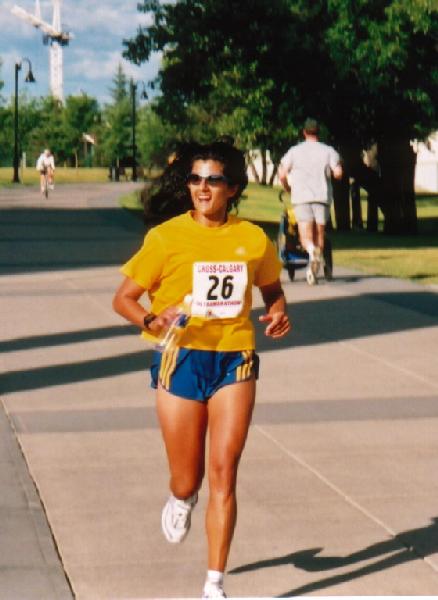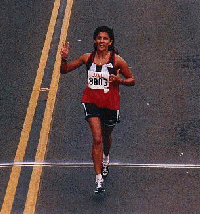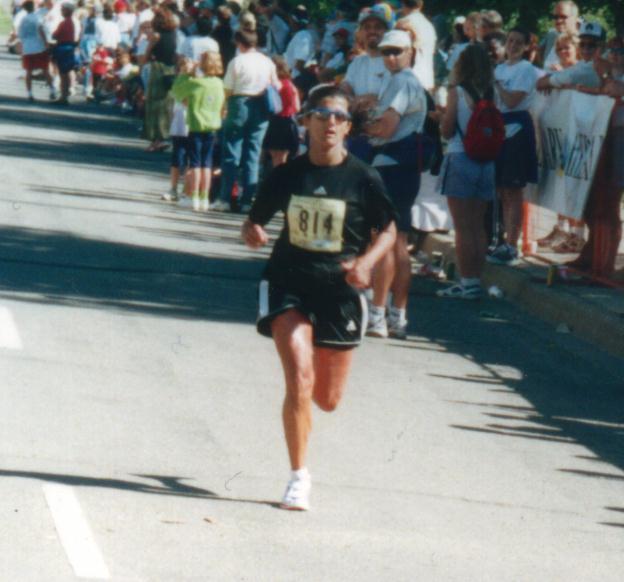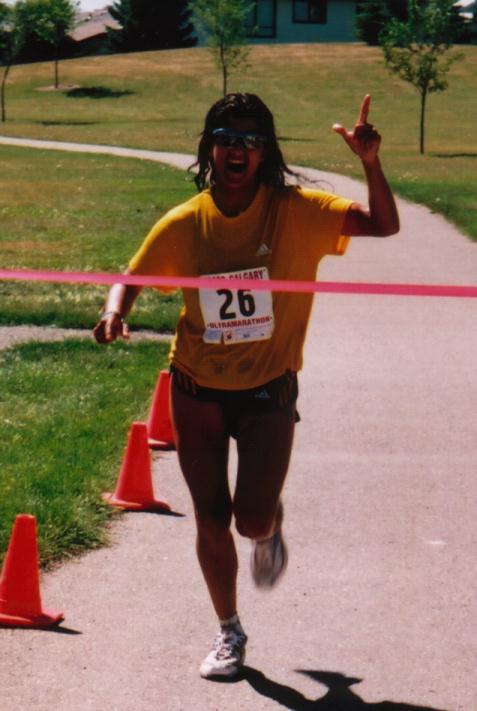Women in Motion
September 2000
Newsletter

enhancing
female performance
Vol 2.
Issue 2
September 2000
WOMEN
IN MOTION NEWSLETTER - September 2000
Vol. 2, No. 2
This
Month Contains:
~News
~Articles
Plantar Fasciitis
~From
Around the 'Net
1. Downhill Running
2. Indoor Training
3. Rest can be Hard Work
4. Walker Support
5. Safe Skin in the Sun
6. Sticking With Your Goals
7. Signs of Overtraining
8. Energy Out
9. Know Your Feet
10. Glucosamine Sulfate, is it
for you?
~Words
of Inspiration
~The Running Woman Board
-The Runner's Club
Survey
Results
Women
in Motion August Survey: How did you start
running?
The
responses were as follows:
Time
Based Program- 45%
Distance
Based Program- 00%
No
Program- 55%
Thanks
for taking the time to help in this survey.
Visit
the site to see the September survey and weekly results.
Advance Article:
Plantar Fasciitis
What is it?
It is an inflammation of the
plantar fascia, a thick, fibrous band of tissue in the
bottom of the foot, running from the heel to the base of
the toes. When placed under too much stress, the fascia
stretches too far and tears, causing inflammation of the
fascia and surrounding tissues. The tears are soon
covered with scar tissue, which is less flexible than the
fascia and only aggravates the problem.
Plantar fasciitis and other
heel pains send more people to foot specialists than any
other complaint.
Symptoms:
Pain at the base of the heel.
Plantar fasciitis is most severe in the morning when you
get out of bed or at the beginning of a run, because the
fascia is tighter at those times. The pain may lessen as
you walk or run.
The bottom of your foot can
also be stiff and achy? Running can become uncomfortable,
even agonizing.
The plantar fascia, consists
of a long band of fibres that attaches at the bottom of
the heel bone and extends to the base of the toes. Pain
occurs when these tissues become irritated or inflamed a
condition known as fasciitis or when small spurs begin to
grow on the heel bone itself.
If you have plantar fasciitis,
you may feel a sharp pain first thing in the morning
because the plantar fascia shortens during the night,
while you're asleep. When you get out of bed in the
morning and start walking around, the band along the
bottom of your foot stretches and pulls on the heel. When
it pulls too hard, pain results. The first several steps
are a killer!
Causes:
Stress, tension and pulling on
the plantar fascia.
Runners with tight achilles
tendons which tend to put more stress on the fasciae, or
high arches and rigid feet, or flat feet that overpronate
are most susceptible. Worn-out shoes, which allow feet to
overpronate, or shoes that are too stiff, which stretch
the fasciae, can also make you more susceptible.
The most frequent cause is an
abnormal motion of the foot called excessive pronation.
Normally, while walking or during long distance running,
your foot will strike the ground on the heel, then roll
forward toward your toes and inward to the arch. Your
arch should only dip slightly during this motion. If it
lowers too much, you have what is known as excessive
pronation.
Other factors which may
contribute to plantar fasciitis and heel spurs include:
...A sudden increase in daily
activities, increase in weight (not usually a problem
with runners), or a change of shoes.
...Dramatic increase in
training intensity or duration may cause plantar
fasciitis.
...Shoes that are too flexible
in the middle of the arch or shoes that bend before the
toe joints will cause an increase in tension in the
plantar fascia.
...A change in running style,
such as starting speed work, running on the ball of your
foot or sudden increase in hill workouts.
It may take six weeks to three
months to heal, or even longer.
Self Treatment:
As with most running related
injuries, an evaluation of changes in your training
should be done.
A decrease in workout
intensity and duration is important. The most important
part of self treatment for this condition is being sure
that your shoes offer motion control and are optimal
controlling the forces that contribute to plantar
fasciitis and heel spurs.
Check your running shoes to
make sure that they are not excessively worn. They should
bend only at the ball of the foot, where your toes attach
to the foot. Avoid any shoe that bends in the center of
the arch or behind the ball of the foot. It offers
insufficient support and will stress your plantar fascia.
Icing after running can also
be helpful. Gentle calf stretching should also be done.
To strengthen the muscles in your arch toe curls or
"doming" can be done. Toe curls may be done by
placing a towel on a kitchen floor and then curling your
toes to pull the towel towards you. This exercise may
also be done without the towel against the resistance of
the floor.
Experts may also recommend
wearing a heel cup or heel cushion in both running and
regular shoes. They may suggest women either permanently
switch from heels to flats or at least try to run in the
morning, before putting on heels.
Prevention:
Preventive measures: Stretch
calf muscles. Strengthen muscles of the foot by picking
up marbles or golf balls with your toes or pulling a
towel toward you with your toes. (Grab some of the towel
with your toes and pull, then release, grab, and pull
some more.)
To help stretch the fascia,
you can perform a similar motion using a golf ball. Start
with the golf ball under the base of your big toe and
roll the foot forward over the ball, then back again;
then move the golf ball to the base of the second toe and
repeat. Do the same motion starting from each toe, always
exerting enough pressure so that you feel a little
tenderness.
Plantar fascia stretch:
Seated on the floor, with one
knee bent and ankle flexed toward you, pull the toes back
toward the ankle. Hold for a count of 10. Do 10 times.
SUMMARY:
Plantar fasciitis is worth
avoiding. There are many simple, effective ways to
prevent it.
--Wear well-cushioned shoes
and don't forget to replace shoes before 350 miles.
--Run on soft surfaces where
ever you can. Try to avoid asphalt and concrete.
--Keep your mileage
consistent. Increase total weekly miles by no more than
10 percent per week.
--When doing speedwork, ease
into it gradually over several weeks.
--Do achilles tendon stretches
regularly.
--Women: don't wear high heels
during the day and then switch to running shoes in the
evening. Run in the morning and then put on your heels.
Women in Motion September 2000
          
FROM
AROUND THE 'NET
1. Downhill
Running
Running up a steep hill can be a challenging moment in a
race or while training.
What is more important than running the uphill is what
waits on the other side. The downhill portion is actually
tougher on a runner's legs, with greater impact on joints
and quads. After the
effort required getting up the hill, it's easy to relax
and forget running
form on the way down.
To descend the hill under control, don't fight gravity,
but use it to your advantage by
increasing your leg turnover rate. Accelerate into the
flat section after a hill.
Check out:
http://www.runningnetwork.com/cgi-bin/rn_display.phtml?id=25656
2. Indoor Training
Treadmills are machines of convenience. When the weather
is poor,
or when you're trying to fit running into your gym
workout, a
treadmill may be what you need.. But step for step, does
it
equal of an outdoors workout? Yes and no. An article at
FitnessLink
this week explores the pros and cons of the treadmill
workout.
The treadmill's motion, along with the lack of wind
resistance,
means that an indoor workout is slightly less challenging
than
running the roads. But runners can compensate by
increasing the
incline of the treadmill. And it turns out that interval
and
speedwork may actually be more challenging on a
treadmill.
Check out:
http://www.fitnesslink.com/exercise/treadmill.shtml
3. Rest can be hard work
After logging hundreds of kilometres of training before a
marathon, the taper period in the two weeks before the
big event can be anti-climactic to a seasoned runner.
This is the time when marathoners need to cut their
mileage way back to give their legs needed rest and to
conserve strength and endurance for the 42.2 km. But
after weeks and months of training, not running takes as
much discipline as the high-mileage training itself.
Active.com this week puts these final days before the
marathon under the microscope, offering a day-by-day
schedule for the last week of training.
Check out:
http://www.active.com/story.cfm?story_id=2233
4. Walker Support
Marathoners can be categorized into two broad camps: the
run-all-the-way camp and the take-frequent-walk-breaks
camp. While the gut-it-out spirit of the first group
tends to have broad appeal, For seasoned runners, the use
of walk breaks during marathon training and the race
itself can prevent injury and even get you to the finish
line faster.
Joe Henderson, a Runner's World columnist and a
walk-break advocate, has a new and somewhat appealing way
of viewing these walk breaks. "If you don't like
that word 'walk,'" Henderson writes in his weekly
column, "then think of it as 'interval training.'
This sounds better to some of you than that the
W-word."
On the track, interval
training means running several fast repetitions with walk
breaks in between. Henderson's suggestion is that this
classic interval training isn't all that different from
walk breaks during long runs. "Interval training is
an honorable practice for helping runners go
faster," he writes. "So why not use
it also for going longer?"
For more, check out:
http://www.joehenderson.com/archive/131.html
5. Safe Skin in the Sun
The warm weather has us thinking of sunny summer runs --
and preparing for proper skin protection during those
sunny runs. BeWell.com has a feature on the best steps to
protect against skin cancer when exercising in the
elements. From running at the proper time of day to
selecting the right waterproof sunblock, the article
offers prudent pointers for protection.
Check out:
http://www.bewell.com/healthy/athlete/2000/sunscreen/index.asp
6. Sticking With Your Goals
The most experienced, most talented, most enthusiastic
runners sometimes feel their motivation die and their
focus slip. This means that it's time to assess training
goals and set new targets to help inject new energy and
excitement into the running routine.
Setting those goals is no easy task, and it often turns
out to be difficult to select goals that are challenging
but still attainable. The Web site of Washington Running
Report offers advice for setting appropriate goals and
keeping your fitness routine on track.
Check out:
http://www.runwashington.com/tips/motivated.html
7. Signs of Overtraining
Soreness, fatigue, insomnia, headaches, waning ambition,
irritability.
They're all the warning signs
of overtraining, and signals that it's time to pull back
in your training.
About.com's sports medicine site puts the focus on
overtraining syndrome, describing detailed symptoms as
well as
appropriate treatment.
For details check out:
http://sportsmedicine.about.com/library/weekly/aa040600.htm
8. Energy Out
Basal metabolism is the process by which energy is
produced by the body. The amount of energy used by the
body at rest is called the basal metabolic rate, or the
BMR. About 60 to 70 percent of the energy used by your
body during the day is to maintain the body's systems,
such as digestion of food, beating of the heart,
breathing, maintaining body temperature, and many other
life-sustaining functions. If you consume more calories
than needed for basal metabolism, you will need to burn
these calories off with some form of physical activity.
Several factors determine the basal metabolic rate. Age
is the one of most influencing factors; generally, the
younger you are, the higher your BMR. This is due to the
fact that during infancy and childhood there are many
growth spurts requiring high amounts of calories. After
you reach 30, your BMR slows down by a rate of one to two
percent a year. It becomes increasingly harder to lose
and keep weight off as you grow older. The
"middle-age spread" is often a result of a
slowing of the BMR and an inclination to be inactive.
Another significant factor is the influence of your body
composition.
Muscle tissue is highly active even at rest. The more
muscle tissue in your body, the higher your BMR. Men
usually have a higher BMR because of their greater
tendency toward lean muscle tissue.
Hormones also play an important part in basal metabolism.
The BMR is likely to change during puberty and pregnancy
due to hormonal changes.
Estimating basal metabolic rate (BMR).
To change body weight from pounds to kilograms, divide
your body weight by 2.2. The answer is your body weight
in kilograms. Your answer is _____kg.
To find your BMR, multiply your weight in kg by the BMR
factor (1.0 males or .95 females). Your answer is _____
calories per hour.
To find your BMR for 24 hours, multiply the calories per
hour by 24.
Your daily BMR is _____ calories. Your answer represents
the number of calories needed daily for the functioning
of your body at rest.
Estimation of the level of energy expended on physical
activity (PA).
Multiply your daily BMR (answer from Step 1, in our
previous tip) by the energy cost factor.
If you're sedentary (you sit most of the day; you stand
two hours and move about slowly; you sew, study, or
type), multiply your BMR by .30.
If your activity is light (you do some walking and much
standing but no strenuous exercise), multiply your BMR by
.40.
If your activity is moderate (you do considerable walking
with little sitting but no limited strenuous exercise),
multiply your BMR by .50.
If your activity is strenuous (little sitting with fairly
strenuous activity), multiply your BMR by .65.
If your activity is very strenuous (little sitting with
strenuous activity most of the day), multiply your BMR by
.80.
The answer is your PA. This answer represents the number
of calories needed to maintain your weight with your
daily activity.
Estimation of the specific dynamic effect (SDE) of food.
Add the daily BMR and the PA. Multiply this answer by .10
to find the SDE. This answer represents the number of
calories needed each day, including activity and the
digestion of food.
Figuring the sum of calories expended on BMR, PA, and SDE
to obtain the total estimated energy expenditure.
Add together the BMR, PA, and SDE, this answer represents
the total number of calories needed each day to maintain
your present weight.
9. Know
Your Feet
The foot is the main base of support for the body. There
are 26 bones, 33 joints, and 20 muscles that control
movement in the foot. The height and shape of the toes
are different for each individual. It's when the arches
and toes deviate from the normal that problems
occur.
The three basic foot types are normal, cavos, and flat.
The ball of the normal foot rests on the ground
regardless of whether the heel is raised. The cavos foot
has a high arch and tends to absorb shock
poorly. The flatfoot has a poor arch and has no rise to
the top portion of the foot when viewed from the side.
When you're selecting shoes, it's important to take into
consideration
your type of foot. You can avoid foot problems by finding
a store that employs a professional shoe fitter who knows
about the different shapes and styles of shoes.
Heel pain is a common problem that's caused by the
chronic pulling of the muscles and tendons on the bottom
of the foot. Sometimes this condition is referred to as
heel spurs. Runners and other athletes who subject the
arch to strain or receive a direct blow to the heel may
experience this problem.
The treatment consists of rest, heat, medication,
stretching exercises, and shoe modification. In a serious
case of heel pain, a physician may prescribe
injections.
Walking and shoe pressure can lead to Morton's neuroma.
This occurs when a nerve to a toe becomes pinched between
the toe joints, toe knuckles, and the shoe. A change in
shoe wear, the use of pads, and the avoidance of
irritating activity can help treat a neuroma. A physician
may prescribe medication and injections. If symptoms
persist, surgery will be required to release or remove
the nerve.
Flexibility exercises are needed to keep our feet in good
shape.
Toe-foot exercises:
- Toe raises-toe point: Sit, placing foot at the
edge of a smooth, flat surface, with toes extending
beyond the edge. Bend toes downward and hold as far as
possible for three seconds. Return to starting position.
Hold for three seconds. Repetitions: 10 times twice a
day, increasing to 30 times, twice a day. This exercise
is recommended for people with hammertoes or toe cramps.
- Toe squeeze: Use cigarette filters or small corks.
Place them between your toes and hold a squeeze for three
seconds. Repetitions: 10 times twice a day, increasing to
30 times, twice a day. This exercise is recommended for
people with hammertoes or toe cramps.
- Golf ball roll: Roll a golf ball under the ball of your
foot for two minutes. This is a great massage for the
bottom of the foot and is recommended for people with
heel pain, arch strain, and foot cramps.
- Marble pick-up: Place 20 marbles on the floor. With
your toes, pick up one marble at a time and put it in a
small bowl. Do this exercise until you have picked up all
20 marbles. Recommended for people with pain in the ball
of the foot, hammertoes, and toe cramps.
- Sand walking: A walk at the beach will strengthen your
toes and is good for general foot conditioning.
Tired, aching feet love a good massage:
- Moisturize your feet with a foot lotion.
- Give yourself a general foot rub for several minutes.
- Dust your feet with a foot powder.
- Continue foot rub until feet are smooth.
- Practice thumb walking. Hold one foot at the toes,
heel, or ankle, and place the thumb of your other hand on
the sole of the held foot. Apply steady pressure with
that thumb, moving up and down the sole.
10.
Glucosamine Sulfate, is it for you?
Tissues in the joints can become damaged when the
lubricating synovial fluids in the joints become thin and
watery. The normal cushioning is lost, and the bones and
cartilage scrape against each other. Weakened bursa sacs
in the joints can cause tendons to rub against the edges
of bones, increasing the chance that the cartilage will
erode and cause problems.
Glucosamine is an amino sugar normally formed from
glucose. A deficiency can cause specific tissue weakness
found in the tendons, ligaments, and synovial fluids in
the joints. Glucosamine sulfate is a natural compound
that can relieve the pain of joint injuries and
osteoarthritis. The dosage will vary depending on body
size. To find out how many milligrams you need a day,
multiply your weight in pounds by 9. Divide the answer
into three doses a day. Expect results in two months.
After 3 to 6 months, you can reduce your daily dosage by
one-third, and after another one to two months, you can
reduce by another one-third. Some people will need to
take the dosages with food to prevent stomach upset,
heartburn, nausea, or indigestion.
Words of Inspiration
"People
who run find their lives so much more enjoyable.
Everything works better: their cardiovascular system,
their
gastrointestinal system, even their ability to
think."
-Dr.
Ralph Paffenbarger, runner and scientist
The
Running Woman Message Board in Diet and Fitness
The Running Woman Message board continues to be active.
We continue to offer advise to all posts. Thanks to all
of you who have provided assistance to members old and
new. Good Luck and Continued Running to all.
Gord
The
Runner's Club
The RUNNER'S CLUB is still quiet, but with the number of
members just over 500. If you are a member, please take
the time to ensure that your email address is the one you
want to use.
A reminder that two features of the CLUB still remain the
ability of members to communicate with each other
privately in the CLUB and the ability to arrange to chat
with each other in the 24 hour chat facility.
Look
for monthly chats to resume in September.
Good Luck and Great Runs
Gord
About
This Newsletter
A reminder that experts - we are not. Information
presented here is a collection of research with a taste
of experience and opinion added for flavour. We don't get
upset if someone disagrees with anything that has been
said or written. In our experience with running groups
here at home, it is difficult to get agreement on most
anything. If it works for you, then it works.
Neither Women in Motion nor the author of this newsletter
provides professional medical advice. The information in
this newsletter is intended to help you better understand
running issues. It is not intended to replace the advice
of a physician. If you read something in the newsletter
that contradicts what your physician tells you in any
way, always follow your physician's advice.
SUBSCRIBE/UNSUBSCRIBE INFO
You are receiving access to this newsletter because you
have subscribed via Listbot. If you do not wish to have
future newletters sent to you, please use that same
system found on the home page to unsubscribe.
If you have any suggestions for topics or questions
please email us. We would like to publish a monthly
newsletter that reflects the interests of the female
runner.
Gordon Samson, Editor
Women in Motion
LEGAL STUFF / SUBSCRIPTION INFO.
"Women in Motion Newsletter" is free, but its
contents are
copyrighted. No one may use the content without
permission of
the author and "Women in Motion". So please let
us know if you
think the information here is important enough to be
re-written.
Spread the Word
Tell your friends they can get the email link to this
free monthly newsletter.
Gordon and Fariyal Samson
Women in Motion
Visit us at
run.to/womeninmotion
Practice
doesn't make perfect, perfect practice makes perfect.
-Fariyal Samson, B.PE, B.Ed
© Women in Motion
 Women in Motion September 2000 Women in Motion September 2000
|





